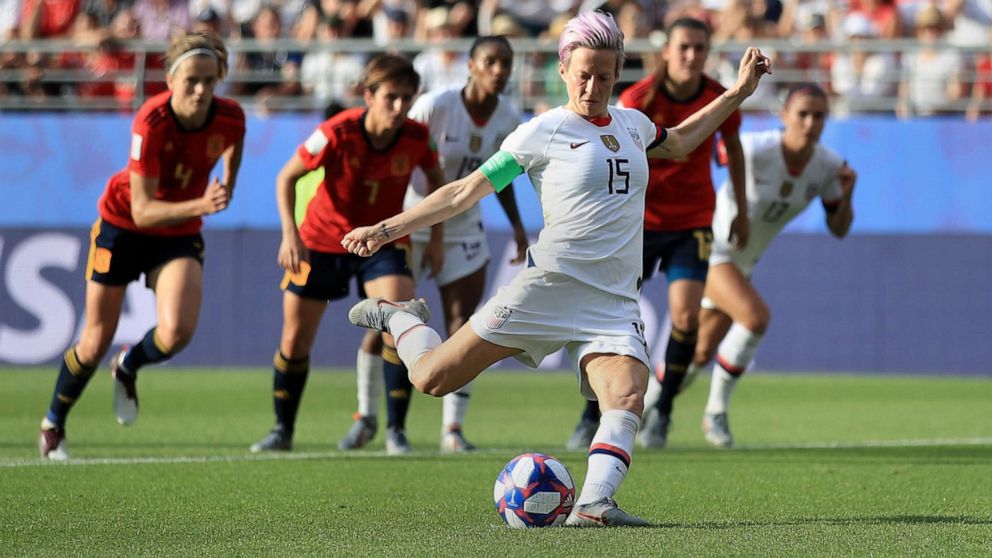The 2019 World Cup soccer ball was expertly designed for aerodynamic success
This is an Inside Science story.
(Inside Science) -- Cristiane Rozeira's left foot struck with the ball as soon as the whistle blew. The ball soared over the barrier, curved gracefully to the right, hit the post and crossed the goal line. It was Rozeira's third consecutive score of the game, and with it she secured the victory for Brazil over Jamaica in the FIFA Women's World Cup 2019, which is taking place in France.
Scoring that goal was no easy feat. It took expertise -- but also a well-designed ball.
This year's official ball, the Conext 19, has practically the same panel design as the Telstar 18, which was the official ball in last year's Men's World Cup in Russia. The graphic design is different, though, as it's inspired by the 1998 Tricolore ball.
The ball used in official matches is designed every four years by Adidas for the men's World Cup and it normally brings some criticism. For example, Italian striker Giampaolo Pazzini complained that the 2010 Jabulani weighed less than usual, and Germany's goalkeeper Marc-André ter Stegen said that last year's Telstar 18 "could be better."
"The footballers that are playing are at the absolute elite level," said John Eric Goff, a physicist at the University of Lynchburg in Virginia. Even if Adidas makes the technical design of the ball similar to what the players expect, he said, "There's going to be little changes, not only in the aerodynamics, but [also in] the way the ball feels when the texture changes slightly, or the panel design changes -- they're going to notice that on their boot."
Players want to be able to predict the ball's behavior in bounce, roll, flight, speed off the foot and grip, wrote sport designer Andy Harland, director of the Loughborough University's Sports Technology Institute in the UK, in an email to Inside Science. "Players are incredibly skillful and when they kick the ball differently, they expect it to behave accordingly."
Goff has been testing soccer balls since 2006. Last year, he and colleagues Takeshi Asai and Sungchan Hong from the University of Tsukuba, in Japan, tested the Telstar 18 and found that the ball's aerodynamic properties are just right for a football match.
The aerodynamics of a soccer ball are simple, but the combination of forces and variables has to be right to make the ball trajectory bend and trick a goalkeeper.
"Once the ball has been kicked and is traveling through the air, there are really very few forces acting on the ball," said mechanical engineer Anette (Peko) Hosoi of the Massachusetts Institute of Technology. "There's gravity, there's drag and there's lift."
In fluid dynamics, drag -- or air resistance -- is a force opposite to the direction of the ball. It can be influenced by the roughness and seams of the ball. In fact, these seams are key to make the trajectory of a ball predictable. A smooth ball would be "terrible," said Hosoi, who founded the MIT Sports Lab.

Picture the air surrounding a soccer ball in mid-flight. A layer of air flows around the front and creates a "messy turbulent" region of high pressure behind the ball, which pushes it forward, said Hosoi. In a straight trajectory, this region would be directly behind the ball, but players like Cristiane like to put a spin on the ball to curve its trajectory. This spin creates a lateral force, called a Magnus force, that moves the "messy turbulent" region to the side and deviates the ball from its forward path, said Harland.
All these forces are also impacted by temperature, air pressure and the aerodynamic properties of the ball. "The degree of Magnus force can be affected by the design and the number of seams," said Harland. The weather, the player's footwear, and the ball's outer surface also play big roles in the amount of spin, which ultimately determines the strength of the Magnus force.
Although this year's Conext 19 has only six panels, the total seam length of the ball is 30% longer than the last significantly different design, which was the Brazuca from 2014. This year, Asai and Hong tested the Conext 19 in a wind tunnel and found that the aerodynamics properties are very similar to the Telstar 18, which was expected since the design is the same.
"I would imagine there was no technical need to change anything,” said Harland.
Inside Science is an editorially independent nonprofit print, electronic and video journalism news service owned and operated by the American Institute of Physics.




